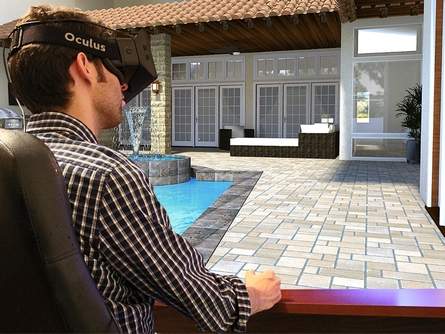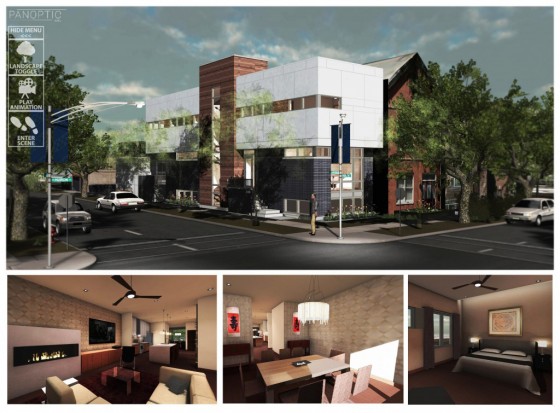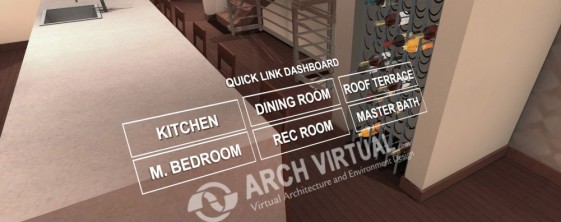Several small companies are seeking a niche; many look to Oculus Rift as the game-changer.
By Kathleen Maher
The new virtual reality (VR) devices coming to the market are products in search of an application. Sure, VR is undeniably cool, but the experience can get boring if there’s no purpose attached to it, and gaming is not a surefire way to make money. Neither is architecture, but companies drawn to the cool factor of VR and augmented reality (AR) are looking at creating virtual walk-throughs as a value-add for architectural design or for real estate.
Avant is a Sarasota startup founded by Frank Elge and Greg Oquera. Both have backgrounds in real estate and some technology experience. Elge is guiding development; Orquera is putting deals together. He was with Century 21 in France, where he used the Avant app to help put together a deal for 33 lots near Paris. The Avant system using the Oculus Rift will enable customers to stroll through a property without ever leaving their chair.

The Avant system uses CAD files to create a 3D model, so obviously, price for the service depends on whether CAD drawings are available for the house and, better yet, whether 3D models are available for the house. It’s still relatively rare for 3D models to be supplied with an architectural design. The company tells reporters the service for creating 3D models can run about $3,000 to $5,000 for a single-family house.
There are, in fact, plenty of applications looking at VR glasses to give a fairly common use of 3D models a little more pizzazz.
Arch Virtual is a team headed by Jon Brouchoud that creates real-time virtual experiences. Working with the Panoptic Group, Arch Virtual developed a 3D walk-through of a property in Chicago. The walk-through can be downloaded and played as a standalone app, or it enables a walk-through to be embedded in a website. Arch Virtual also developed a version compatible with the Oculus Rift system, which is downloaded as a standalone app.

Arch Virtual says the ability to walk through a 3D model will enable developers or customers to experience a building before construction starts. The company says they can use models from Revit, 3ds Max, or other 3D modelers, but they say they can also work with 3D PDF files. Roman Popovych, Jr., of Panoptic says the use of virtual walk-throughs “helped us sell this property much faster than we could have otherwise. It was very cost-effective, and has proven to be a helpful marketing tool for our business.”
Is any of this sounding familiar?
Software for 3D walk-throughs popped up in the ’90s, but most of the dedicated apps have disappeared because the ability to create walk-throughs is now included with modeling software, and companies preferred hiring experts to create their walk-throughs for them or they hired their own in-house experts. In general, a walk-through uses a pared-down version of the CAD model, or, more often, they are built from scratch in tools with better rendering like Lightwave, Max, Maya, or Modo.
Unity, because it is free for non-commercial applications, is often used to create walk-throughs. At the Unity site, there is a blog post dedicated to creating architectural walk-throughs. However, if the goal is to embed a walk-through in a browser, Unity does not yet support WebGL.

Immeractive is a Belgian company that has created its own 3D engine called Haeva to create walk-throughs. The company was founded in 2010, and it develops 3D tools for applications in construction and heritage promotion. It is being used for architecture, real estate, urban planning, regional planning, heritage, museums, and tourism. The company is operating as a service and creates 3D models from whatever content is available including architectural blueprints, geographical information, and archival documents. The company is enthusiastic about the potential for Haeva coupled with the Oculus Rift. The company says, “Since our Haeva technology is modular, our team quickly adapted our 3D engine to allow our virtual models to run on this promising immersive device.”

Another player in this field these days is up and coming Cl3ver, a company that lets people use their own models, or it offers templates for creating a 3D model that can be adjusted to create custom models of homes and office buildings. Cl3ver takes advantage of WebGL so that the app can be delivered via a browser. Luca Vidotto tells us that Cl3ver is looking into supporting VR and specifically the Oculus Rift, but they are not ready to specify a date. However, Vidotto says the interactivity is built in for Cl3ver apps; it is part of the interface so there’s no need for JavaScript programming. He notes that the application was developed specifically for AEC and manufacturers, so he believes it’s easier to use than more complex game engines.

WebGL is an important piece of the puzzle. Most of the applications for 3D browsers have not been created for stereoscopic viewing. That’s a piece of the puzzle that is just coming along, thanks to the enthusiasm engendered by VR headsets. There are several projects going on to enable VR for WebGl. CubicVR is a good example. It’s a JavaScript utility that enables 3D WebGL content to be converted to stereoscopic views.
What do we think?
Although Oculus Rift has sucked up all the attention, there are several companies working on VR glasses with various amounts of immersion. Sony’s Project Morpheus is a very sleek version, and Epson’s Moverio glasses are lightweight and have a see-through option so one does not have to feel so isolated in the VR environment.
The companies we found for this article are the early adopters. There will be more. Architecture is not the killer app for VR. We’re pretty confident saying that, but the killer app for VR might well turn out to be a lot of content for all sorts of different applications including games, shared experiences, 3D immersive movies, museum exhibits, telepresence, and all the other apps that are mentioned. Also, it seems inevitable that devices with 3D vision are coming in the near future, and as the number of devices goes up, so will the applications.





